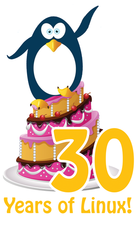This month we celebrate the steady and powerful Linux kernel
Kernel Talk

We celebrate 30 years of Linux with a special issue that takes you inside the kernel and shows you how to take your first steps with the kernel community.
Birthdays are always important, and birthdays that end in zero are especially significant. 30 years of Linux? Seriously? I guess we always knew that Linux was cool, but those of us who were around the water cooler in the early 90s when the first mentions of a new free operating system began to trickle out to Usenet groups never would have guessed that Linux would ever get as big as it is today, running on web servers and washing machines, desktops, cell phones, Mars rovers, and supercomputers around the world.
When we were considering a topic for the 30th birthday of Linux, it soon became clear that the only real way to celebrate was to write about Linux itself – not the agglomeration of software we know as a Linux distro, but the real Linux – the beating heart in the center of it all: the Linux kernel.
When it comes to birthdays, I should add: We ship this magazine all around the world, and it arrives on different shores on different dates over a range of almost two months. So I'm not sure when this issue will actually reach you, but the date we are commemorating is August 25, 1991, when a Finnish college student named Linus Torvalds left a message on the MINIX newsgroup announcing that he was working on a new operating system.
[...]
Buy this article as PDF
(incl. VAT)
Buy Linux Magazine
Subscribe to our Linux Newsletters
Find Linux and Open Source Jobs
Subscribe to our ADMIN Newsletters
Support Our Work
Linux Magazine content is made possible with support from readers like you. Please consider contributing when you’ve found an article to be beneficial.

News
-
Parrot OS Switches to KDE Plasma Desktop
Yet another distro is making the move to the KDE Plasma desktop.
-
TUXEDO Announces Gemini 17
TUXEDO Computers has released the fourth generation of its Gemini laptop with plenty of updates.
-
Two New Distros Adopt Enlightenment
MX Moksha and AV Linux 25 join ranks with Bodhi Linux and embrace the Enlightenment desktop.
-
Solus Linux 4.8 Removes Python 2
Solus Linux 4.8 has been released with the latest Linux kernel, updated desktops, and a key removal.
-
Zorin OS 18 Hits over a Million Downloads
If you doubt Linux isn't gaining popularity, you only have to look at Zorin OS's download numbers.
-
TUXEDO Computers Scraps Snapdragon X1E-Based Laptop
Due to issues with a Snapdragon CPU, TUXEDO Computers has cancelled its plans to release a laptop based on this elite hardware.
-
Debian Unleashes Debian Libre Live
Debian Libre Live keeps your machine free of proprietary software.
-
Valve Announces Pending Release of Steam Machine
Shout it to the heavens: Steam Machine, powered by Linux, is set to arrive in 2026.
-
Happy Birthday, ADMIN Magazine!
ADMIN is celebrating its 15th anniversary with issue #90.
-
Another Linux Malware Discovered
Russian hackers use Hyper-V to hide malware within Linux virtual machines.

